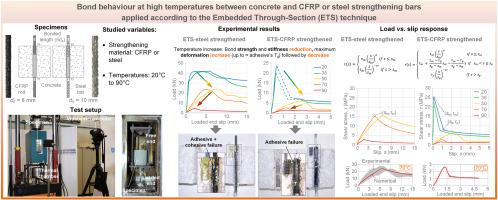当前位置:
X-MOL 学术
›
Cement Concrete Comp.
›
论文详情
Our official English website, www.x-mol.net, welcomes your feedback! (Note: you will need to create a separate account there.)
Bond behaviour at high temperatures between concrete and CFRP or steel strengthening bars applied according to the embedded through-section (ETS) technique
Cement and Concrete Composites ( IF 10.8 ) Pub Date : 2024-05-07 , DOI: 10.1016/j.cemconcomp.2024.105580 Adriana S. Azevedo , João P. Firmo , João R. Correia
Cement and Concrete Composites ( IF 10.8 ) Pub Date : 2024-05-07 , DOI: 10.1016/j.cemconcomp.2024.105580 Adriana S. Azevedo , João P. Firmo , João R. Correia

|
The embedded through-section (ETS) technique is an efficient shear-strengthening method for reinforced concrete (RC) structures, in which fibre reinforced polymer (FRP) or steel bars are bonded in holes predrilled in RC members. Compared to conventional FRP strengthening methods, ETS systems are expected to present better performance when exposed to high temperatures/fire, due to the insulation provided by concrete to both adhesive and FRP/steel components. Yet, the mechanical/bond properties of the strengthening materials are highly affected when the glass transition temperatures () of their components is attained/exceeded; however, there are no studies available about the influence of elevated temperatures on the performance of ETS systems. This paper presents an experimental study that addresses the effects of elevated temperatures on the bond behaviour of ETS systems – pull-out tests were conducted on steel rebars or sand-coated carbon-FRP (CFRP) rods bonded with epoxy adhesive on concrete cylinders at temperatures up to 90 °C. The results obtained confirm that the strength and stiffness of the bonded interfaces decrease when the temperature in the adhesive approaches/exceeds its ; moreover, with sand-coated CFRP rods, failure was also influenced by the bond between the sand coating and the CFRP rods core, and thus the average bond capacity was significantly reduced for temperatures below the of the epoxy adhesive. Bond-slip relations were calibrated for different elevated temperatures for the steel/CFRP-concrete interfaces using data obtained from the pull-out tests; these bond laws can be used to simulate the mechanical behaviour of ETS-strengthened-RC members subjected to elevated temperatures.
中文翻译:

根据嵌入截面 (ETS) 技术应用的混凝土与 CFRP 或钢筋之间的高温粘结行为
嵌入式贯穿截面 (ETS) 技术是一种有效的钢筋混凝土 (RC) 结构抗剪加固方法,其中纤维增强聚合物 (FRP) 或钢筋粘合在 RC 构件中预钻的孔中。与传统的 FRP 加固方法相比,ETS 系统在暴露于高温/火灾时预计会表现出更好的性能,因为混凝土为粘合剂和 FRP/钢构件提供了绝缘作用。然而,当达到/超过其成分的玻璃化转变温度 () 时,增强材料的机械/粘合性能会受到很大影响;然而,目前还没有关于高温对 ETS 系统性能影响的研究。本文介绍了一项实验研究,旨在解决高温对 ETS 系统粘合行为的影响——在一定温度下,对用环氧树脂粘合剂粘合在混凝土圆柱体上的钢筋或涂砂碳纤维增强塑料 (CFRP) 杆进行拉拔测试高达 90°C。获得的结果证实,当粘合剂中的温度接近/超过其温度时,粘合界面的强度和刚度会降低;此外,对于涂砂的CFRP棒,失效还受到砂涂层和CFRP棒芯之间的粘合的影响,因此当温度低于环氧粘合剂的温度时,平均粘合能力显着降低。使用拉拔试验获得的数据,对钢/CFRP-混凝土界面的不同高温下的粘结滑移关系进行了校准;这些粘合定律可用于模拟 ETS 强化 RC 构件在高温下的机械行为。
更新日期:2024-05-07
中文翻译:

根据嵌入截面 (ETS) 技术应用的混凝土与 CFRP 或钢筋之间的高温粘结行为
嵌入式贯穿截面 (ETS) 技术是一种有效的钢筋混凝土 (RC) 结构抗剪加固方法,其中纤维增强聚合物 (FRP) 或钢筋粘合在 RC 构件中预钻的孔中。与传统的 FRP 加固方法相比,ETS 系统在暴露于高温/火灾时预计会表现出更好的性能,因为混凝土为粘合剂和 FRP/钢构件提供了绝缘作用。然而,当达到/超过其成分的玻璃化转变温度 () 时,增强材料的机械/粘合性能会受到很大影响;然而,目前还没有关于高温对 ETS 系统性能影响的研究。本文介绍了一项实验研究,旨在解决高温对 ETS 系统粘合行为的影响——在一定温度下,对用环氧树脂粘合剂粘合在混凝土圆柱体上的钢筋或涂砂碳纤维增强塑料 (CFRP) 杆进行拉拔测试高达 90°C。获得的结果证实,当粘合剂中的温度接近/超过其温度时,粘合界面的强度和刚度会降低;此外,对于涂砂的CFRP棒,失效还受到砂涂层和CFRP棒芯之间的粘合的影响,因此当温度低于环氧粘合剂的温度时,平均粘合能力显着降低。使用拉拔试验获得的数据,对钢/CFRP-混凝土界面的不同高温下的粘结滑移关系进行了校准;这些粘合定律可用于模拟 ETS 强化 RC 构件在高温下的机械行为。











































 京公网安备 11010802027423号
京公网安备 11010802027423号